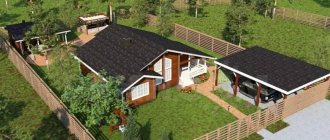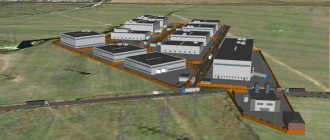The agricultural sector plays a big role in the state's development strategy.
Therefore, much attention is paid to it in the Russian Federation. If a person decides to engage in agricultural activities, he must receive a plot of land for a peasant farm. Applicants are subject to special requirements. At the legislative level, the possibilities of using land and liability for violation of norms are prescribed.
The concept of peasant farm land
Territories that are intended for agricultural activities and located outside the boundaries of administrative points are approved and described in the Land Code in Art. 77-81.
Thus, the options for activities that are legal in territories of this type of land are indicated:
- Agricultural production;
- Storage and processing of agricultural raw materials;
- Research work and scientific activities in the field of agriculture.
Legislative framework on plot sizes
When determining specific plots for a peasant farm (peasant farm), personal subsidiary plot (LPH), KFK or agricultural production, it is imperative to take into account the maximum possible legal size. This determination is made by representatives of the local administration or the current government of the constituent entity of the Russian Federation. If the size of the plot is too large, the owner will be denied entry into the cadastral list. Such a system makes it possible to prevent the accumulation of land plots under one owner or from small fragmentation of the territory.
Federal normative act “On Peasant Farming” No. 74 dated June 11, 2003 presupposes the possible size of land plots. To carry out targeted activities.
Table: Possible dimensions of plots.
| Locality | Minimum value | Maximum value |
| Moscow | 0,02 | 40 |
| St. Petersburg | 0,06 | 50 |
| Pyatigorsk | 0,06 | 50 |
| Novosibirsk | 0,04 | 50 |
| Khabarovsk | 0,1 | 50 |
| Ekaterinburg | 0,1 | 50 |
| Nizhny Novgorod | 0,03 | 25 |
| Rostov-on-Don | 0,08 | 50 |
Like the minimum values, the maximum parameters of peasant farms and agricultural land are regulated by the legislation of the subject of the Russian Federation.
Important! Territories with boundaries that were previously determined, have a cadastral number and have received an owner are not subject to comparison with the current parameters.
Which category of land is better for farming?
The choice of farm depends on the purposes for which it is created. For families who plan to provide products only for themselves, private household plots are suitable. There is no need to apply to the tax authority, report and pay taxes on income. When creating private household plots, you will have to rely only on your own funds, because a bank loan is not issued for these purposes.
If the goal is production of products and their sales, i.e. making a profit, then you need to register a peasant farm. This means registration with the tax authority and the obligation to pay taxes. Farmers can count on assistance for farm development from the state in the form of various subsidy programs, as well as receiving borrowed bank funds.
Contents of the law on peasant farms
The normative act consists of 23 points, divided into 9 parts. The first chapter sets out the general rules and regulations.
The concept of peasant farming includes not only production resources, but also transportation and storage options for products.
It is not enough to simply grow agricultural products Source bvi-en.ru
A peasant farm can be created either by an individual or a group of persons. A legal entity (organization) may not be created necessarily. This issue is regulated by the Civil Code in Art. 86.1. Here is a brief description of the first paragraphs of this act:
- Individuals conducting collective activities in the agricultural sector, on the basis of Article 23 of 74-FZ, can create a legal entity to organize labor work.
- Transactions with the property of such a legal entity are regulated on the basis of property rights.
- An interested party can be a member of only one such business organization.
- Members of peasant farms as a legal entity bear subsidized liability. This means that the creditor can collect the debt from another person, a member of the peasant farm. If it is not possible to pay, the plot will be sold at auction to a person who meets all the requirements for the intended use of a particular plot.
Possible types of farms
After determining the type of peasant farm, it is easier to decide on its type of activity. There are four such types in total:
- Khutorskoe peasant farm. It is characterized by a compact location; all buildings are built, as they say, from scratch. Due to the fact that this type of farming requires large financial investments, it is not very popular. However, if you need a large space for future activities, this option will be suitable.
- Bran farming. It is large enough and suitable for a rotational method. Typically, there is a dense arrangement of various buildings here, which forces the entrepreneur to think about logistics. However, its advantages are that it allows the combination of several types of livestock farming.
- A large-scale peasant farm is based on an agricultural organization that turns out to be unprofitable. Having acquired such a plot, the farmer may not demolish the existing buildings, but use them for his activities. As a rule, this type of farm “inherits” the type of activity from the one that the previous organization was engaged in.
- A rural farm is located near a populated area. In this case, logistics will be cheaper than in others, but environmental standards limit this type of peasant farm activity. This should not be ignored, since possible conflicts - with environmental services or the population - can significantly slow down business processes.
Not only the possible activities of the enterprise, but also the amount of start-up capital and other nuances depend on the type of farm.
Properties of peasant farms approved by law
An organization of citizens should be formed on the voluntary desire of the parties
All individuals are responsible for each other before government agencies.
It is expected that each member of the organization will take part in the activities of the business enterprise.
Teamwork Source planeta-2014.ru
If a peasant farm is formed without creating a legal entity, legal regulation is carried out at the expense of the Civil Code and regulation No. 74-FZ. Thus, government officials need to support such entities, including resolving financial issues.
Disadvantages of peasant farming
But there are also disadvantages. Firstly, registering the type of activity of a peasant farm costs more than registering the same individual entrepreneur. In addition, the founder is obliged to use the land for its intended purpose (land intended for growing crops should not be used for grazing livestock). A peasant farm participant cannot be a member of another similar organization. Well, it is important to take into account the dependence of rural entrepreneurs on seasonal risks, weather conditions, diseases of livestock and plants, etc. Farmers often work for several years without profit or at a loss.
Peasant farm registration process
All residents of the state have the right to create a peasant farm on the territory of the Russian Federation:
- Civilians;
- Stateless persons, foreigners.
According to the law, the organizer of a peasant farm can add no more than 3 of his relatives who have reached the age of 16 to its composition. At the same time, the formation may consist of up to 5 people who are not related to the head of the enterprise. The following parameters must also be observed:
- Parties involved must attach copies of identification documents and proof of family ties, if any, to the papers.
- The main document of the agreement does not limit the signatories in changing the forms of farm activity. It is possible to update documents based on new tasks.
- It is required in the initial sample agreement to stipulate in advance the possibility of changing the document.
- All parties to the agreement must sign an approved document regulating the operation of the farm.
The activities of peasant farms are subject to the charter Source zhazhda.biz
Peasant farms must be registered with state authorities, regardless of whether a legal entity or an individual submits papers. This procedure is not strictly regulated.
See also: Popular plots in the Moscow region for building a country house.
Features of the use of unified agricultural tax
Agricultural tax can only be used by farms for which the relevant activity is the main one. The share of income from the sale of agricultural products must be 70% or more.
Existing peasant farms, users of the simplified tax system or OSNO, can switch to the unified agricultural tax from the beginning of the new calendar year. New companies are advised to submit an application for a change in tax regime at the same time as their registration documents.
Unified agricultural tax users have to report to the tax authorities once a year – in March. Summary data is entered into the Unified Agricultural Tax declaration, according to the book of income and expenses. It is important to take into account the existence of restrictions on allowable costs.
The agricultural tax rate is 6%. It is paid in two stages: advance payment - until July 25 of the current year, actual - until April 1 of the year following the reporting one. In case of delay, the taxpayer is charged a penalty.
Penalties are also provided for failure to submit a declaration and non-payment of taxes. Forgot to submit a report and pay your budget? Be prepared to pay 20% of the assessed tax amount.
Distinctive qualities of peasant farms and private household plots
Chapter 3 establishes the property of members of peasant farms, which fundamentally distinguishes this point from the rest. Property rights in such organizations are the basis for relationships, as shown by 3 decades of existence of such forms of organizations. Law No. 201-FZ provides a complete list of forms of property for peasant farms.
The list of possible material benefits includes:
- Land territories
- Properties in the square
- Buildings for irrigation system, other production facilities
- Cattle and poultry
- Household products
- Transport technology
- Tools for ensuring the work of peasant farms
- Manufactured products
- Cash received through peasant farms.
Peasant farms are characterized by the following features:
- An agreement between members stipulates the order of ownership;
- Activities must be carried out in common interests;
- The guarantor of transactions is property;
- The head of the farm must establish transactions in the area of interest of all owners.
- A person who refuses to participate in a farm has the right only to monetary compensation, without the option of allocating a separate plot.
On state support for peasant farming
Here it is necessary to say a few words separately. This is one of the few types of business that has secured very tangible government support. For example, preferential lending conditions, when subsidies are given to repay part of the loan interest rate. There is also one-time or grant financial assistance for the creation and maintenance of the chosen type of peasant farm activity. There is also property support in the form of transfer of ownership of plots of land, premises, equipment, transport, inventory, equipment, etc. - on the basis of a lease agreement with preferential terms.
Legal characteristics of peasant farm lands
The regulatory act of the Russian Federation dated June 11, 2003 No. 74-FZ states that a peasant farm is an association of persons to ensure economic activity. Thus, peasant farming is an option for entrepreneurship on an economic basis.
The regime of peasant farm plots in the field of legal regulation has specific conditions due to a number of features. Among the main regulations that regulate the provision and acquisition of land are the Land Code of the Russian Federation, the Civil Code (Civil Code) of the Russian Federation and No. 101-FZ dated July 24, 2002.
Based on the form of work of the subject, the legal status of the land plot may change slightly.
Legal forms of agribusiness Source bizness.pp.ua
In addition to the privatization of land after the collapse of the USSR, it is also possible to transfer land for organizing farming activities, including free of charge, at the expense of the municipal land balance. Such actions are regulated by Art. 33 of the Land Code of the Russian Federation.
It is necessary to highlight the concept of shared ownership - the transfer of part of the territory from common ownership to the private real estate of a participant in shared ownership. After such a transaction, the participant in whose favor the transfer was made loses his rights to the common property.
Based on the Federal Law on the State Cadastre, such a plot must be registered in the federal cadastral register. The Federal Law “On the turnover of agricultural land” has simplified the process, provided that there are more than 5 people in shared private ownership.
The owner of shared ownership, based on Article 252 of the Civil Code of the Russian Federation, can voice in writing his intention to allocate a share or shares, or use the allocated media.
In Art. 20 of the Land Code of the Russian Federation specifies the procedure for the process of privatization of certain territories in favor of creating farm production. On the right of unlimited use and on the terms of lifelong ownership.
Regulation of the land issue
The land issue for peasant farms is reflected in several legal acts. The following laws are important among them.
- Federal Law No. 74-FZ regulates the possibility of constructing facilities on a peasant farm site. The document allows construction on existing territories.
- The distribution of peasant farm lands occurs in accordance with the regulations prescribed in the Federal Law “On the turnover of agricultural land” No. 101-FZ.
- Farms that own land have special rights. They can challenge the municipality's decision to grant the plot. In this case, you should contact the judicial authorities.
Construction on agricultural lands
Based on the form of use of the area, the construction of certain structures and structures is permitted. Today in land law there are several different types:
- The peasant farm is a peasant farm:
- SNT - horticultural enterprise. This also includes areas for the construction of summer cottages;
- Subsidiary farm.
Currently, construction is planned:
- Dachas of a personal building on the territory for agricultural work.
- Facilities for storing various resources;
- Cottages for living all year round. Possible only on the territory of a household plot or farming areas.
Buildings on peasant farm lands Source stargate-rasa.info
Before purchasing land, you must familiarize yourself in detail with the documents for the land plot. The papers contain a mandatory list of types of work that are permitted in a specific territory.
Types of permitted activities for peasant farms:
- Arable land;
- Haymaking;
- For the purposes of personal gardening with or without the possibility of construction;
- For plant growing, gardening;
- Agricultural production;
- For grazing, pastures.
When purchasing a plot, you should carefully read the documentation, pay attention to the category and permitted types of activities. Some real estate agencies claim that changing the category can be done very easily and quickly. But most often the procedure is either very lengthy or not feasible at all.
In addition, a representative of local authorities is responsible for the cadastral registration estimate. There are a number of reasons why you may be refused. The practice of refusals in such cases is very common.
Is it possible to transfer land from one category to another in the future?
The owner of a land plot has the right to apply to the local authority with a request to change the type of permitted use. This applies to the transfer of private household plot land outside the settlement to peasant farms or vice versa. With a personal plot, such actions are impossible.
To change the VRI, an application and a package of documents are submitted to the administration, on the basis of which a decision will be made. After consideration, a positive or negative answer is given. In the first case, the owner receives one copy of a document confirming the decision of the territorial body to change the allotment’s temporary registration record, as well as an extract from the Unified State Register of Real Estate with new data.
Every citizen has the right to organize his own subsidiary or farm and receive a plot of land for these purposes. Each type of activity has its pros and cons. Therefore, you need to accurately determine the goals of creating a farm: only satisfying your interests or making a profit. Depending on the goals, the type of organization of private household plots or peasant farms is selected.
FacebookVKontakte
Buildings on the territory of peasant farms
If a citizen decides to build a country house, one of the simplest and most profitable options would be to purchase a plot of territory for summer cottage construction or gardening activities.
Marked plot for summer cottage construction Source baavar.mn
For such a case, there is no need for permission from the authorities. In addition, during registration under the “dacha amnesty” this permission is not required.
In the case of peasant farms, land of this type is distributed in large plots - from 3 hectares. However, in order to erect a structure, the land owner will need to justify the need to create a particular structure. The only justification for building a cottage will be the organization of a livestock farm, which requires daily presence on the territory.
It is worth noting that a livestock farm does not have to be of impressive size. 20 heads of poultry and some rabbits are enough. Legislative acts do not contain precise characteristics of such undertakings.
Before starting construction work on the KFK site, it is necessary to obtain consent from representatives of the local administration. For this purpose, it is necessary to provide certificates confirming the right of private ownership, papers on classifying the land as a peasant farm and the desired design of the building.
Today, legislation has become more lenient on the issue of registration in the area of farm settlements and gardening friendly organizations. However, as a rule, even court proceedings do not end with a positive decision. This is due to the lack of clear criteria for assessing premises and the possibility of registration only in a judicial form.
What is LPH?
The concept of personal subsidiary plot (LPH) is enshrined in Federal Law dated July 7, 2003 No. 112-FZ. This is a form of non-entrepreneurial activity associated with the production and processing of products grown independently. It can be carried out by several people, but all of them should be united by family ties and the purpose of obtaining agricultural products should be to satisfy personal needs.
Land with the permission of private household plots can be within the settlement and beyond its borders. In accordance with Art. 4 of Law No. 112-FZ they can be used:
- for the production of agricultural products, as well as the construction of a residential building and outbuildings, if located within the boundaries of the settlement (garden plot);
- only for the purpose of growing agricultural products, if the plot is located outside the settlement (field plot).
Land for private plots can be leased from the municipality or purchased as private property.
Deprivation of ownership rights to peasant farms
Issues of alienation are approved in the legislation of the Russian Federation. The plot is withdrawn from ownership in the following cases:
- Territory cluttering:
- Soil poisoning:
- Destruction of fertile soil:
- Damage to the soil.
To legally deprive a site, an official examination is necessary.
A positive result may occur if there are chemical or toxic waste on the site.
Also, representatives of government bodies may refer to the lack of use of land for its intended purpose. This situation can be resolved by planting several fruit trees or shrubs.
Peasant farm land must be used for its intended purpose Source bizcapital.ru
Which territories are suitable for peasant farms?
The area is close to transport infrastructure and various electricity transmission lines. This saves money.
- Availability of communications will reduce the time before the enterprise starts operating. This also allows you to maintain the proper level of sanitary standards.
- Territories with a sufficiently large area
- Sites with a nearby settlement.
The nearby administrative center will allow you to quickly transport the necessary resources. It is also easy to find hired workers and regulate all issues with the administration of the locality.
Briefly about the main thing
Thus, peasant farms are a universal option for immovable land property to meet rural and economic needs. To build on such a territory, a number of documents and permits are required. However, many concepts are not properly regulated by law.
| A little more attention! Write in the comments what you think - should only farmers manage land for peasant farms for themselves, or can it be considered as a business organization? |
Ratings 0
Read later
Reasons for demolishing buildings
In some cases, a building constructed on the territory of a peasant farm may be demolished. This is provided for:
- causing damage to nearby buildings and neighbors;
- placing the structure near a highway or infrastructure;
- building a house within a protected natural area.
The decision to demolish a building is made in court. The owner must fulfill it. He will not be compensated for his expenses and expenses. In other cases, it is impossible to oblige demolition.







